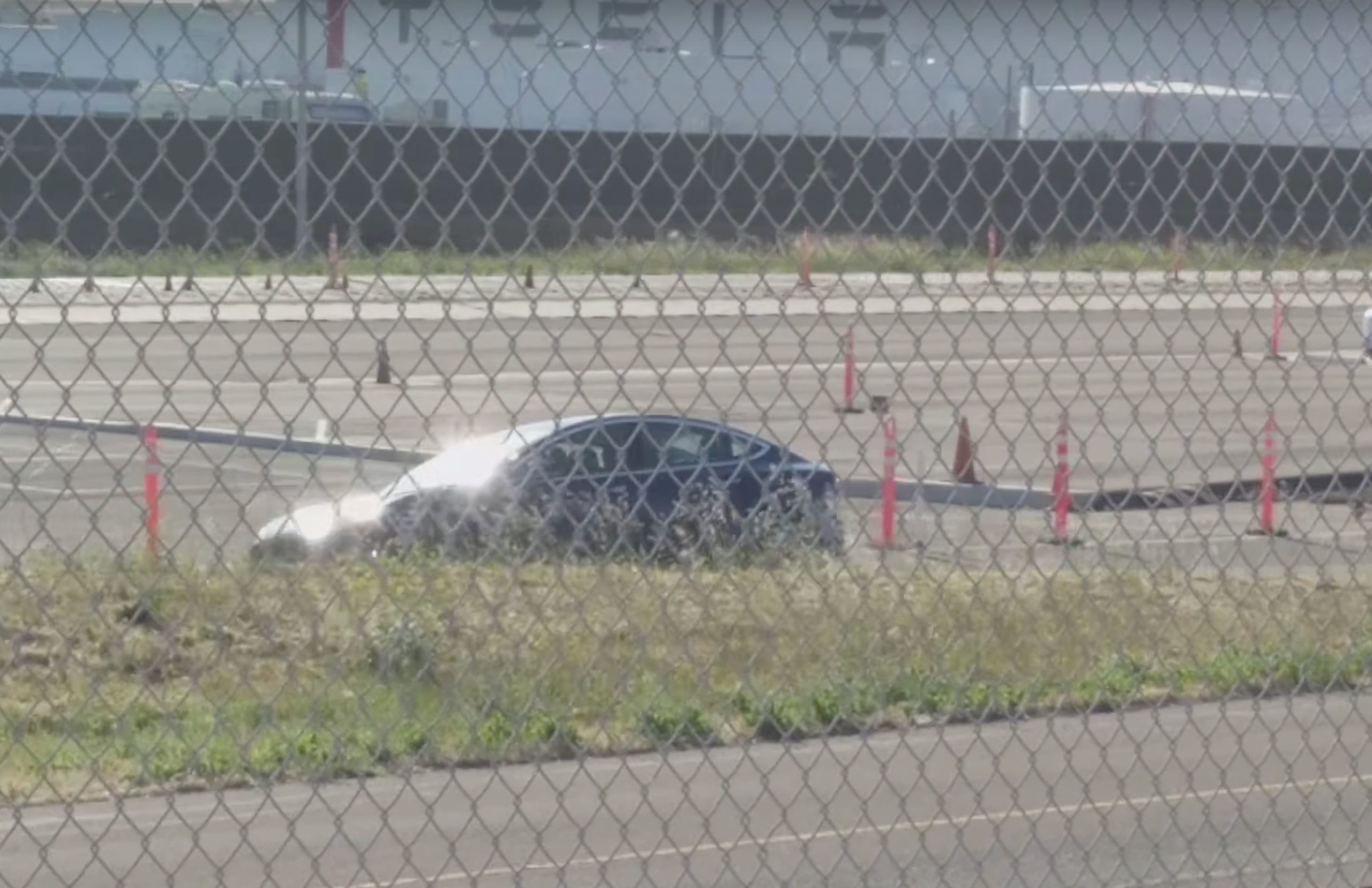
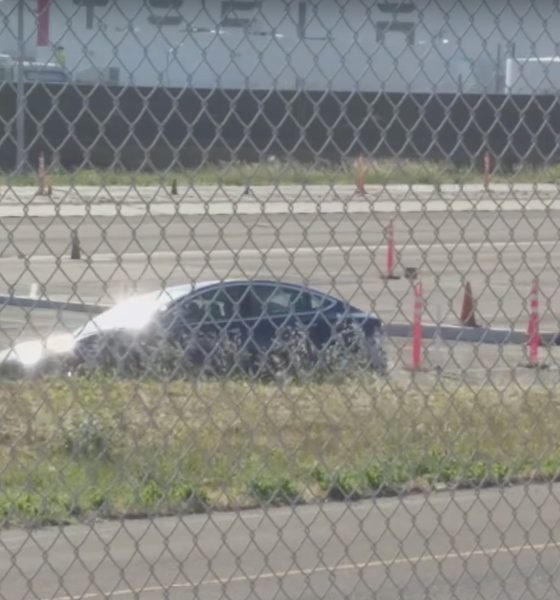
News
First look at Tesla Model 3 on test track at Fremont factory [Video]
A new video posted by YouTuber Andrew Batiuk includes some great footage of the Tesla Model 3 zipping around the test track located behind the company’s Fremont, California-based factory.
The video opens with the Model 3 waiting on the track with the front trunk (frunk) open and a suitcase popped open with some tools in it. After a brief wait, a Model S showed up with more tools and started “working on” the vehicle. The Model 3 was back on the track after a brief delay and took a few laps before leaving the property.
In the Model S, there isn’t much in the way of mechanical equipment in the frunk area but given the complete ground up approach Tesla took with the Model 3 design, this could have changed. The technician was likely performing suspension adjustments on the Model 3. Unlike the Model S and Model X which includes an electronically-actuated air suspension, Model 3 will initially arrive with a coil suspension.
The videographer followed the Model 3 as it left the Fremont factory track and headed to an offsite commercial park a few blocks away for safe keeping. Seen in the YouTube comments, Andrew noted that “this ‘base’ was an unmarked building, where 20 unfinished Superchargers sat in the parking lot.” With Model 3 and staged Superchargers on site, it is clear that the location is a Tesla facility.
The video is some of the best footage we have seen of the Model 3 in action, and from all appearances it is certainly going to deliver a slightly less fancy version of Model S in a much more affordable package.

News
Lucid and Uber team with Nuro for new robotaxi program with Gravity SUV
The plan currently is to launch it to the public in the Bay later this year.
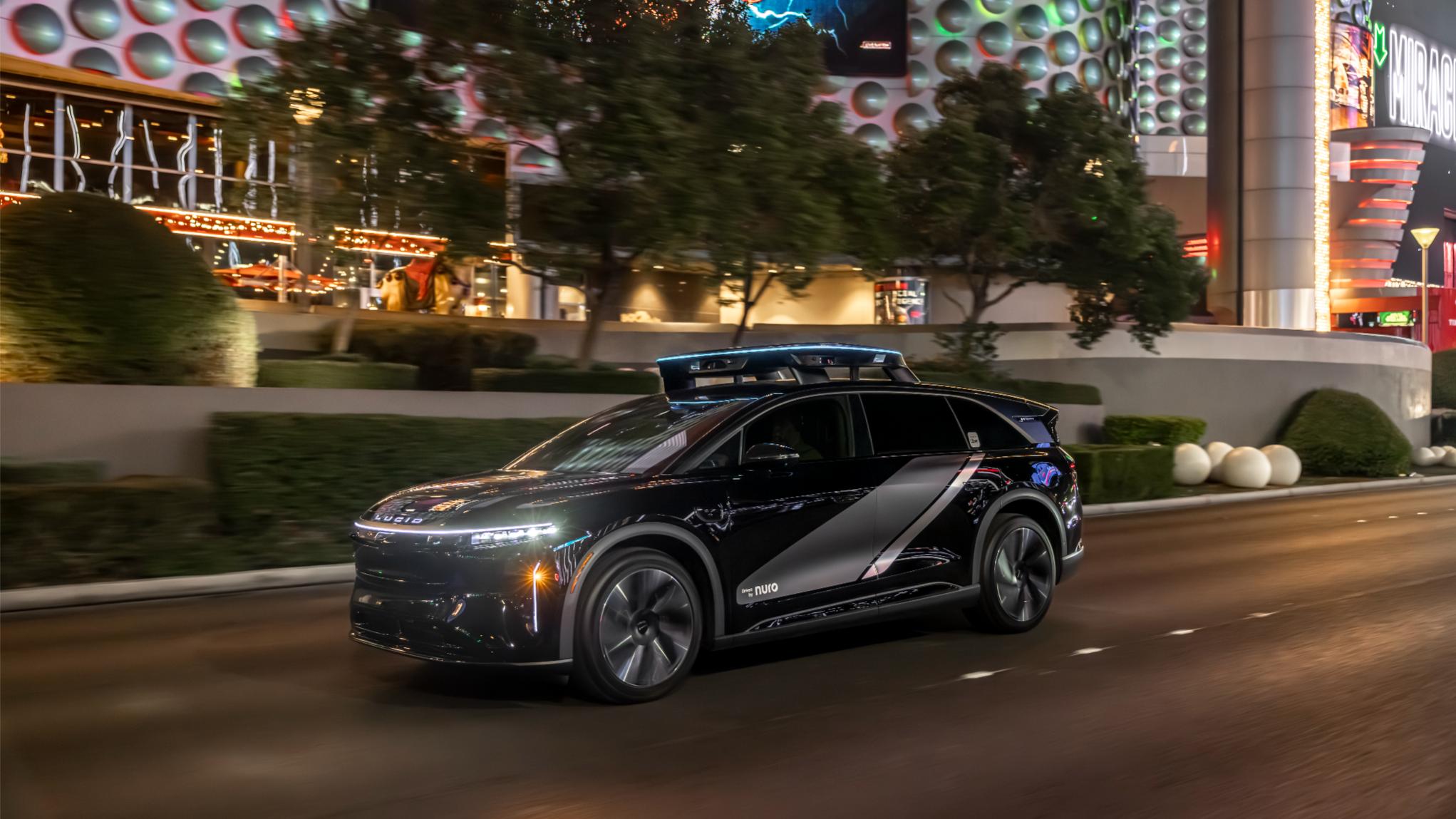
Lucid and Uber are teaming up with Nuro to launch an autonomous robotaxi program utilizing the automaker’s Gravity SUV. The project will be unveiled at CES 2026, introducing an in-cabin rider experience completely designed by Uber, the world’s largest ride-sharing service.
Back in 2025, the partnership between the three companies was announced, aiming to launch a unique ride-sharing platform using over 20,000 Lucid vehicles equipped with the Nuro Driver technology. The vehicles are owned and operated by Uber.
The companies have already initiated some testing in the San Francisco Bay Area, which is a big step in the right direction for the project. The plan currently is to launch it to the public in the Bay later this year. Nuro will lead the testing using robotaxi engineering prototypes that are supervised by autonomous vehicle operators.
Currently, there are over 100 robotaxis in the Engineering Test Fleet.
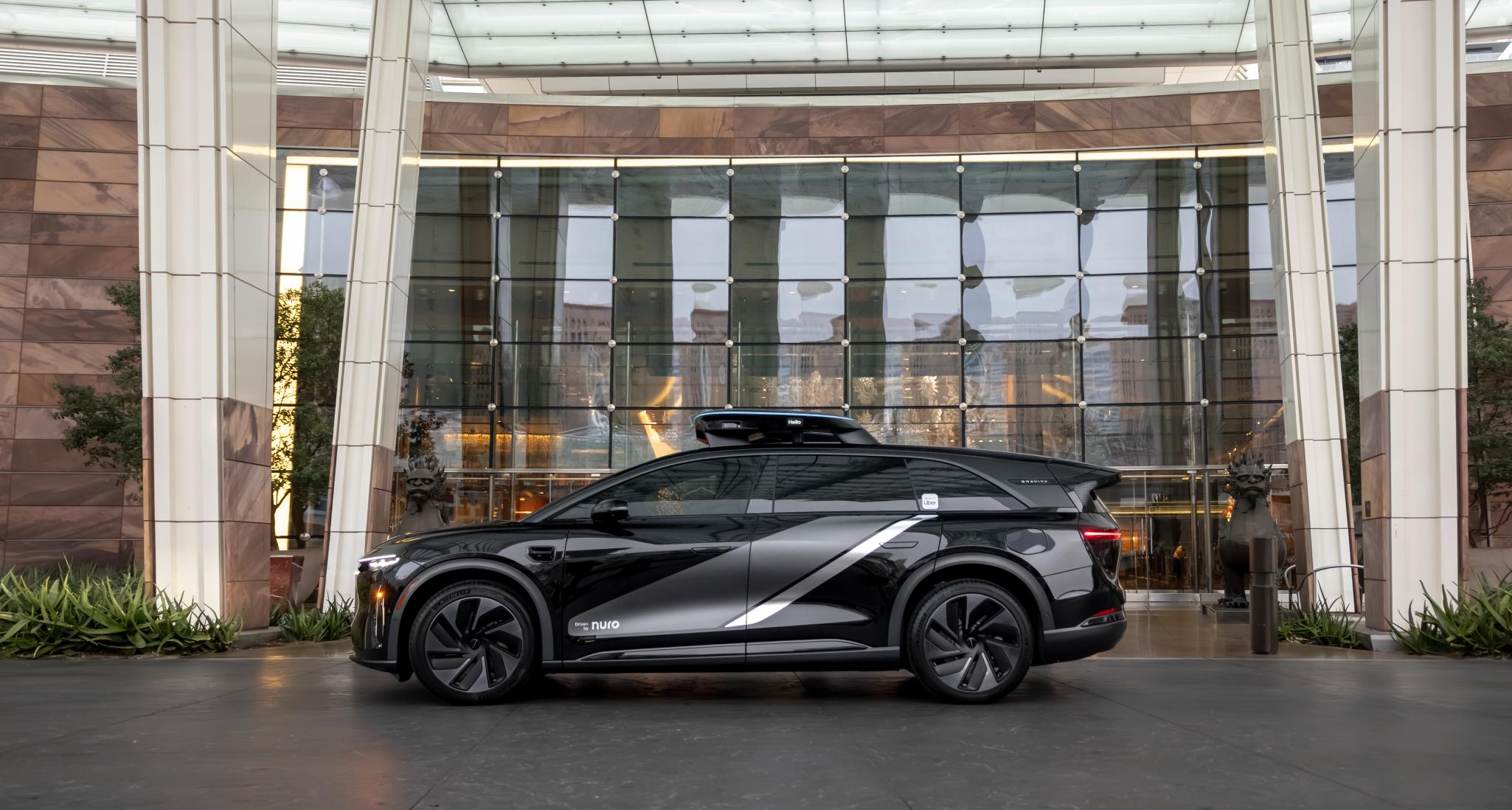
The Gravity vehicles are fitted with a next-gen sensor array featuring high-res cameras, solid-state LiDAR sensors, and radars that will provide a 360-perception model, as well as a “purpose-built roof-mounted halo designed to maximize sensor visibility,” which is seen on top of the Gravity unit above.
The halo also has integrated LEDs to help riders more easily identify the correct vehicle by displaying their initials. The halo will also provide clear status updates from pickup through dropoff.

These units for the robotaxi program between the three companies will start being produced later this year at Lucid’s Arizona AMP-1 factory.
Uber chose the Lucid Gravity specifically due to its “unprecedented comfort” and its reputation, as it was named to Car and Driver’s 10 Best for 2026. But Uber is customizing some things for the Gravity so that it is specifically catered to robotaxi riders:
- For the first time, Uber is designing the in-vehicle rider experience, which will include interactive screens with entertainment and climate control options, as well as support contacts and vehicle maneuver requests, like a request to pull over.
- It will also have in-vehicle visualization, showing what the robotaxi sees and its path in real-time. This will be a nice transition for those who are skeptical about driverless vehicles, and will show what the vehicle and its sensors, LiDAR, and cameras see.
- The Gravity is also a sizeable SUV, which will give riders space for themselves and their luggage.
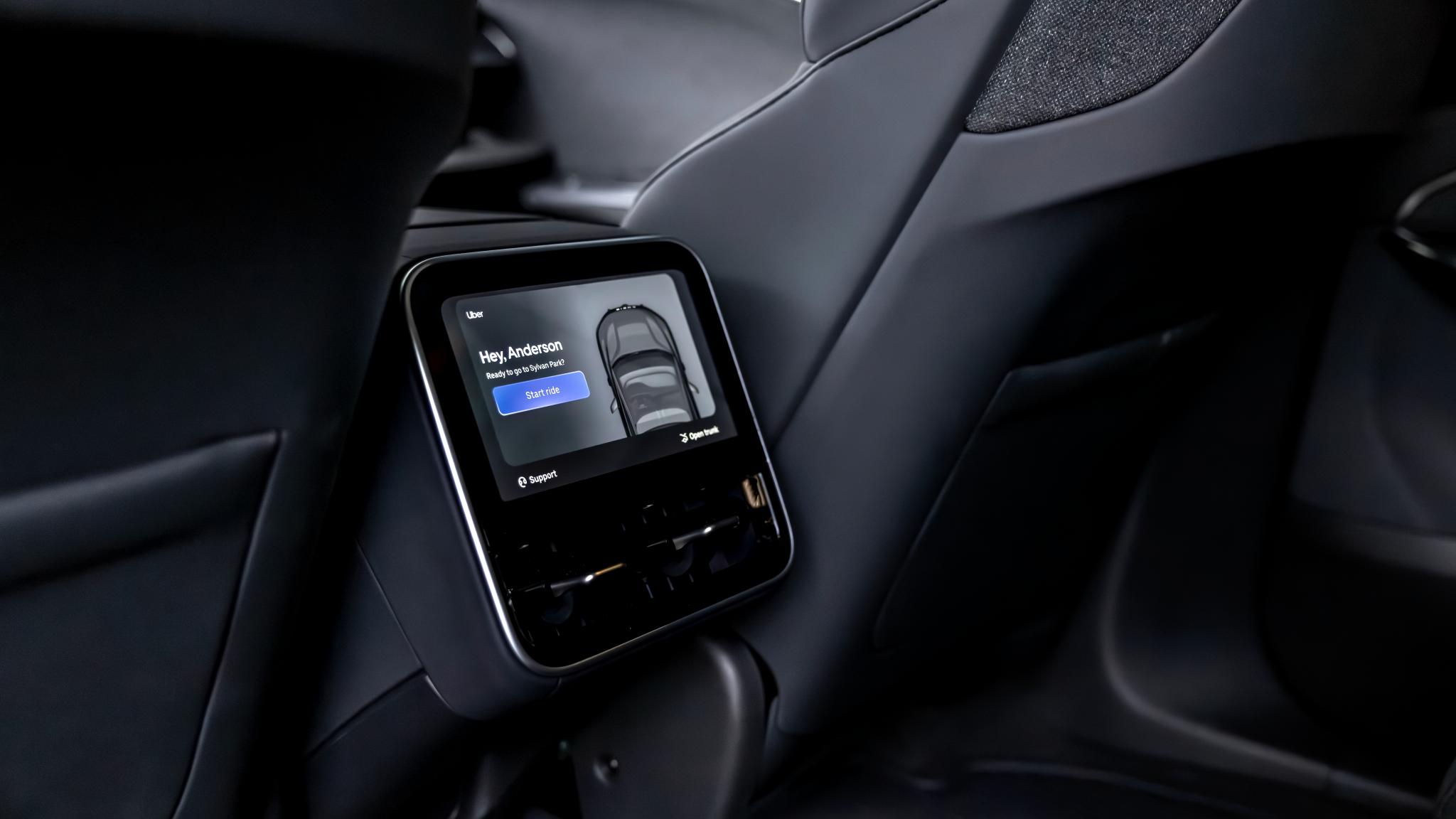
This is the latest application of a ride-hailing platform that leans on autonomy for its operation, essentially phasing out the need for human drivers in various markets, starting with the Bay Area.
More companies are dipping their toes in the project, giving them the opportunity to establish some early momentum, as there are only a handful of companies that are currently operating this in the United States. Uber, Lucid, and Nuro aim to be the next, and initiating this program at this time is big for their chance at success.
News
Tesla Cybercab test fleet expands in Austin and Bay Area
In total, the Robotaxi fleet is comprised of 139 total vehicles in both Austin and the Bay Area. The vast majority of these units are Model Y cars, but the Cybercab is the most recent addition to the fleet.
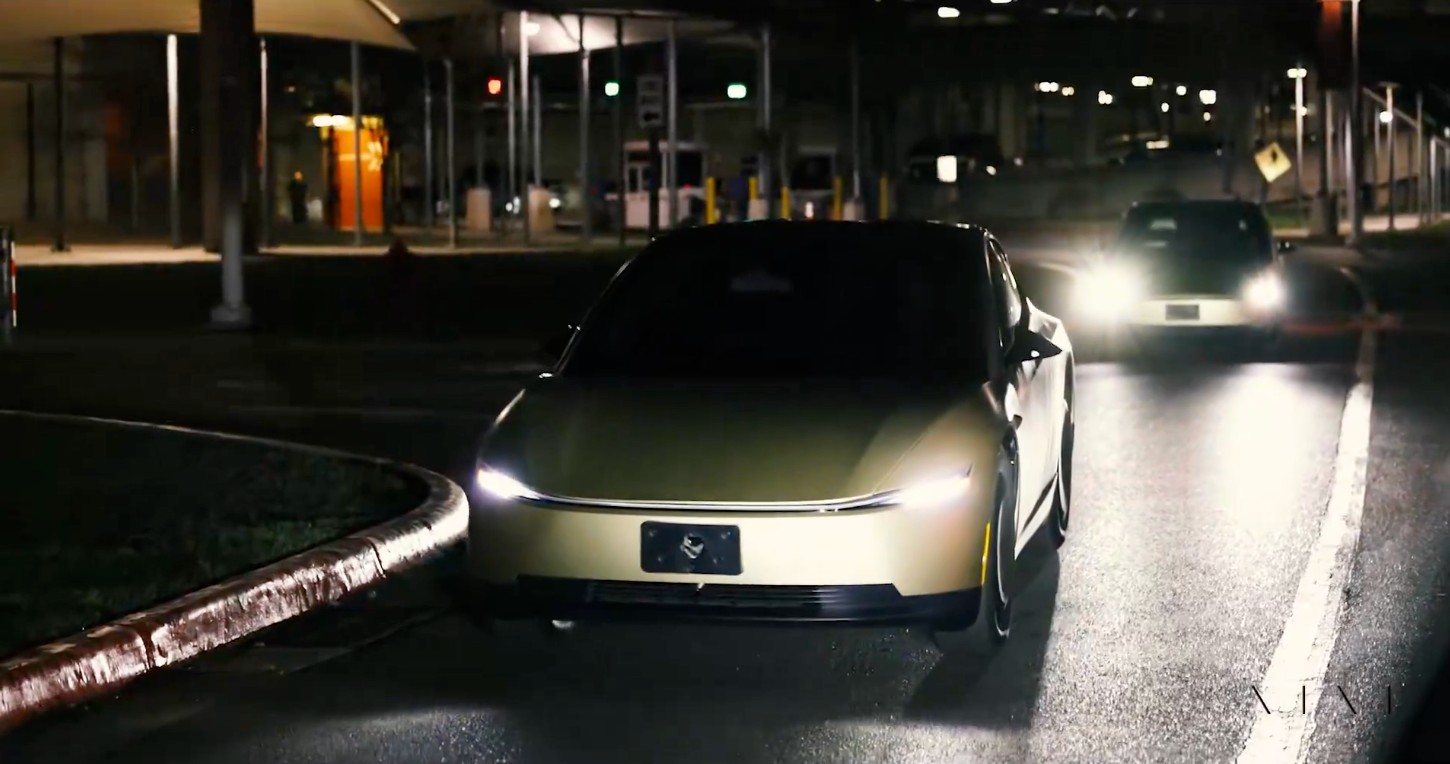
Tesla has expanded its fleet of Cybercab test units in both Austin and the Bay Area of California, as the vehicle is heading toward the first production stages, hopefully early this year.
As the first few units were spotted in Austin late last year, Tesla is now operating seven total Cybercab units in testing, three of which were spotted over the weekend in Texas. Bay Area testing just started on January 3, with both units also being added to the fleet on Saturday and Sunday.
In total, there are seven Cybercabs now operating, according to Robotaxi Tracker, each with different license plates that have been observed over the course of the last several weeks; the first unit was spotted in Austin on December 18.
The future should look like the future, indeed.
The Cybercab really changes the look of the roads, but without the shock factor of the Cybertruck. It’s a pretty good balance, imo.pic.twitter.com/PM0KbjzhxR
— TESLARATI (@Teslarati) December 22, 2025
The expansion of the Cybercab test fleet is a slow but steady process that Tesla is taking to get the car on public roads ahead of its initial production stages.
CEO Elon Musk said last week that Tesla has already started some test production phases of the vehicle at Gigafactory Texas, which is located outside of Austin.
Tesla Cybercab tests are going on overdrive with production-ready units
However, it will likely be some time before Tesla actually adds it to the fleet for rides that are available to the public. Tesla plans to build it without a steering wheel or pedals, so the company will have to reach Level 5 autonomy at that point before customers can hail rides and take it to their destination.
In total, the Robotaxi fleet is comprised of 139 total vehicles in both Austin and the Bay Area. The vast majority of these units are Model Y cars, but the Cybercab is the most recent addition to the fleet.
News
Tesla Germany’s “Giga Train’s” improved service gets rave reviews
As per recent reports, Tesla’s free “train”Giga Train” service will increase its daily trips to six starting this week.

Tesla has expanded its employee shuttle service from Berlin Ostbahnhof East Station to the Gigafactory Berlin-Brandenburg. As per recent reports, Tesla’s free “train”Giga Train” service has increased its daily trips to six starting this week.
The service has so far received positive reviews from the facility’s employees, some of whom noted that the upgraded shuttle train has reduced their travel time by a notable margin.
Giga Berlin’s expanded shuttle service
As noted in a rbb24 report, Giga Berlin’s free shuttle train now operates six times daily, up from one previously. The service also goes directly to the Model Y production facility without stopping at other stations. Tesla employee Dené Schunck described the service to rbb24 in a comment: “The shuttle goes directly to the factory site, without any transfers, which reduces the commute time for our employees by almost half,” Schunck stated.
Operated by Ostdeutsche Eisenbahngesellschaft (Odeg) after switching from Niederbarnimer Eisenbahn (NEB), Giga Berlin’s shuttle train, which also stops at Ostkreuz and Erkner, remains free for all riders, including non-Tesla employees. It has been fully funded by Tesla Germany since September 2023.
Employees praised the changes: One Giga Berlin worker stated that it “definitely makes the journey easier” because employees “used to need two hours for the round trip from Berlin, but now it’s significantly faster.”
Tesla Germany’s previous comments
In late 2025, reports emerged stating that Tesla Germany will be expanding its shuttle train service by adding direct rail trips from Berlin Ostbahnhof to Giga Berlin-Brandenburg. In a comment, Tesla Germany stated that the updated service would mirror the shift changes for the Model Y factory’s employees.
“The service includes six daily trips, which also cover our shift times. The trains will run between Berlin Ostbahnhof (with a stop at Ostkreuz) and Erkner station to the Gigafactory,” Tesla Germany noted.
At the time, Tesla Germany also stated that despite construction being done at Fangschleuse and Köpenick stations, the route of the Giga Train has been optimized to maintain a predictable 35-minute travel time. This should provide Tesla Germany’s employees with a convenient way to travel to and from Giga Berlin.








